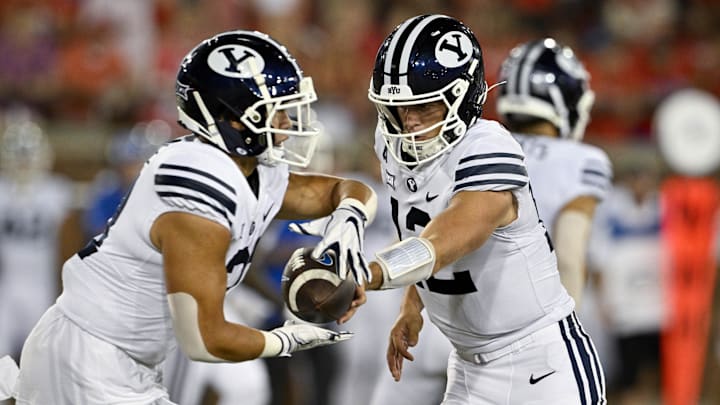BYU's Offense Regressed in Week Two - But They Weren't Alone

Following BYU's 18-15 upset win over SMU, most fans were concerned about the BYU offense. The concern was warranted - BYU scored only 18 points and failed to get a first down on 9/14 drives. While BYU's offense will undoubtedly need to improve if the Cougars are going to continue their winning streak, a look across the league suggests that it's not time to panic yet.
Why? Most Big 12 teams regressed on offense in week two.
In week one, 11 of the 16 Big 12 teams played FCS teams. Of the five teams that didn't play FCS teams, two of them played New Mexico (who had lost to an FCS team already) and Wyoming (who lost to an FCS team in week two). Outside of West Virginia and TCU who played against Power Five teams, the competition level was fairly similar across the board in week one.
The Big 12 dominated those games against FCS/low-level G5 teams in week one, scoring an average of 44 points per game.
In week two, most Big 12 teams faced P4 competition. 10/16 Big 12 teams faced P4 foes and Texas Tech faced Washington State, a team that was in a conference up until this season. That step-up in competition proved to be a challenging one for Big 12 offenses, including BYU.
Here are the 11 teams in the Big 12 that went from G5/FCS opponents in week one to P4 opponents (including Washington State for this example) in week two.
- Kansas - Scored 48 points in week one (Lindenwood); scored 17 points in week two (Illinois)
- Colorado - Scored 31 points in week one (North Dakota State); scored 10 points in week two (Nebraska)
- Utah - Scored 49 points in week one (Southern Utah); scored 23 points in week two (Baylor)
- Oklahoma State - Scored 44 points in week one (South Dakota State); scored 39 points in week two (Arkansas)
- Cincinnati - Scored 38 points in week one (Towson); scored 27 points in week two (Pittsburgh)
- Iowa State - Scored 21 points in week one (North Dakota); scored 20 points in week two (Iowa)
- Baylor - Scored 45 points in week one (Tarleton State); scored 12 points in week two (Utah)
- Houston - Scored 7 points in week one (UNLV); scored 12 points in week two (Oklahoma)
- Texas Tech - Scored 52 points in week one (Abilene Christian); scored 16 points in week two (Washington State)
- BYU - Scored 41 points in week one (Southern Illinois); scored 18 points in week two (SMU)
- Arizona State - Scored 48 points in week one (Wyoming); scored 30 points in week two (Mississippi State)
In total, the scoring average of Big 12 teams dropped from 44 points against FCS/low-level G5 teams in week one to 20 points against P4 teams in week two. Those averages, of course, are in line with BYU's scoring outputs of 41 points and 18 points against Southern Illinois and SMU, respectively.
Nearly every school experienced some level of drop-off in week two. The only exceptions were Houston and Iowa State and those two teams have something in common: their offenses weren't great in week one, so there wasn't as much room for regression. Houston, for example, improved from scoring 7 points against UNLV in week one to 12 points against Oklahoma in week two. So yes, technically they improved, but not many Houston fans are feeling encouraged about the state of their offense through two weeks.
It's worth noting that Oklahoma State's final score is misleading. The Cowboys had a pick-six on defense and eight points in overtime to boost their scoring output. In regulation, Oklahoma State's offense scored 24 points.
Also, don't forget about Arizona. The Wildcats put up 61 points against New Mexico in week one before scoring only 22 points and narrowly escaping FCS foe NAU in week two. Arizona put up only 25 more yards of offense ono NAU than BYU did on SMU.
Of the 12 aforementioned teams, BYU was in the middle of the pack in terms of total yardage.
- Texas Tech - 491 total yards against Washington State
- Cincinnati - 449 total yards against Pittsburgh
- Arizona State - 428 total yards against Mississippi State
- Oklahoma State - 385 total yards against Arkansas
- Iowa State - 361 total yards against Iowa
- Arizona - 361 total yards against Northern Arizona
- BYU - 336 total yards against SMU
- Kansas - 327 total yards against Illinois
- Houston - 318 total yards against Oklahoma
- Utah - 292 total yards against Baylor
- Colorado - 260 total yards against Nebraska
- Baylor - 223 total yards against Utah
After watching week two unfold in the Big 12, there seems to be a moral to this story:
- BYU's offense needs to improve
- BYU's offense isn't the only offense in the conference that struggled; it's not time to panic yet
With no preseason in college football, it's common for offenses to struggle against their first Power Four opponents. Perhaps that was the case for BYU against SMU. There is still time for BYU to get a lot better on offense in 2024.
BYU's offense needs to start scoring points sooner rather than later, because early returns suggest the defense is good enough to win a lot of football games.
